I hope your New Year is off to a healthy good start, but if not here is some information that will help. And if it is off to a good healthy start this will keep it going in that direction.
The lymphatic system is often overlooked in our understanding of staying healthy. I find this especially important as I get older. The Lymphatic system can slow down or become sluggish from many different factors, aging is one of them. This can cause pain and discomfort. Once you read Lucy’s description of the lymphatic system you will understand why there is pain and what to do about it.
Lucy Rush is an amazing Lymphatic massage practitioner. I asked her to explain in brief the Lymphatic system. In case you don’t know where your lymphatic system is located check this site for deeper understanding.
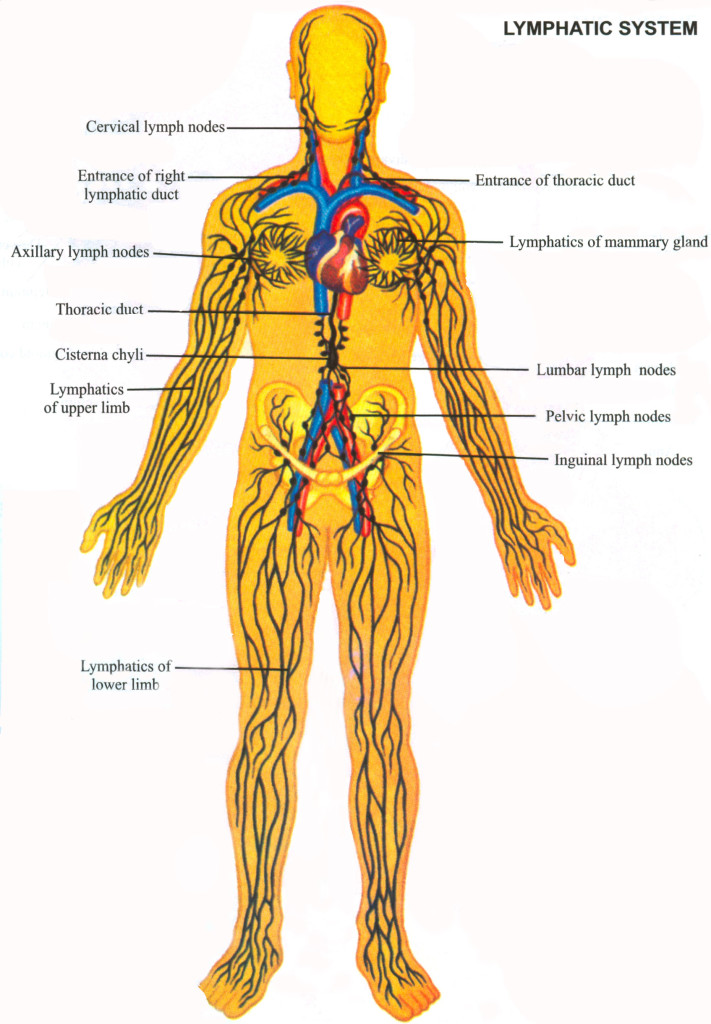 Lucy’s Synopsis:
Lucy’s Synopsis:
The Lymphatic system is a fluid transport system, consisting of lymphatic tissues and lymph vessels. It is an integral part of our immune system and thus functions to protect us in several ways. Our lymphatic tissues, including our lymph nodes, are involved in the production and distribution of lymphocytes, which are white blood cells. B-cells and T-cells are two of the three types of lymphocytes. B-cells produce antibodies and T-cells help B-cells, as well as aiding in the elimination of viruses. Lymph vessels create and move lymph fluid. Lymph fluid is a clear liquid, comprised mostly of water (96%) along with a varying mixture of proteins, lipids, hormones, toxins, bacteria, cell waste, etc. Lymph nodes purify lymph fluid by filtering out, neutralizing or destroying any pathogenic substances or microorganisms.
 The way in which you might be the most familiar with the lymphatic system is in the tissue swelling (edema) and tenderness one can get during a cold, flu or after a surgery. Lymphatic massage can be beneficial towards the end cycle of illness and post-operatively, as well as helping to strengthen the immune system for those who suffer from allergies or autoimmune diseases. It is a group of gentle, relaxing massage techniques that support comfort, recovery and wellness. These techniques help increase the flow rate of lymph as it moves through the node areas, enhances lymph node function and aids in detoxification. There are many benefits of lymphatic massage. The reduction of edema is perhaps the most visually apparent benefit and has a wonderful ripple effect. Decrease of swelling supports reduction of pain, discomfort and stiffness, helps to lessen numbness and enables mobility of muscles and joint range of motion.
The way in which you might be the most familiar with the lymphatic system is in the tissue swelling (edema) and tenderness one can get during a cold, flu or after a surgery. Lymphatic massage can be beneficial towards the end cycle of illness and post-operatively, as well as helping to strengthen the immune system for those who suffer from allergies or autoimmune diseases. It is a group of gentle, relaxing massage techniques that support comfort, recovery and wellness. These techniques help increase the flow rate of lymph as it moves through the node areas, enhances lymph node function and aids in detoxification. There are many benefits of lymphatic massage. The reduction of edema is perhaps the most visually apparent benefit and has a wonderful ripple effect. Decrease of swelling supports reduction of pain, discomfort and stiffness, helps to lessen numbness and enables mobility of muscles and joint range of motion.
“I apply Integrative Lymphatic Massage on a broad spectrum of conditions. These include sinus and bronchial congestion, abdominal bloating and discomforts, joint sprains, cosmetic surgery post-op, and internal organ and cancer surgery post-op. I am continually amazed at the effectiveness of lymphatic massage and its cumulative results and enjoy teaching my clients simple techniques and practices that they can do at home to support their health and wellness.”
(CLICK HERE to read more)
Lucy Rush, CMT is a massage therapist and educator. She is in private practice specializing in Integrative Lymphatic Massage, Acupressure and Swedish/Deep Tissue techniques. She has been an instructor at the San Francisco School of Massage for the past twenty-one years and teaches at two other schools in the greater Bay Area and abroad.
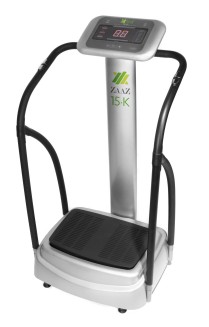 One of the newest exercise machines, the ZAAZ, purports to move the lymphatic and circulatory systems as well as give you one hour of exercise all in 12 minutes.
One of the newest exercise machines, the ZAAZ, purports to move the lymphatic and circulatory systems as well as give you one hour of exercise all in 12 minutes.
Sound too good to be true? Actually I think it is great but remember there are no magic solutions. It is still very important to have the awareness of how you are using your body while you are on the machine, and to understand your alignment. It’s still important to walk and move in a variety of ways. However, 12 minutes on the machine is really better than not doing any movement. Besides the there is a sense of relaxation and energy I get when I use the ZAAZ machine.
Another great way to get things moving is to attend the upcoming workshop, “Spring Cleansing and the Alexander Technique” lead by Denise Aubin and special guest: yours truly, Elaine Belle. Click Here for the workshop flyer.
Hopefully this information about your Lymphatic system is inspiring you to pay closer attention to your body and give you an understanding your many different systems working in your body that keep you healthy. The human body is truly a wondrous work of art. Being of aware of the multilayered systems and how amazingly each system works together gives one reason to pause and appreciate this gift of life.
All the best,
Elaine

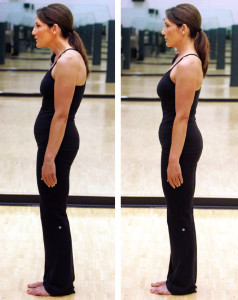 When my shoulders are tight or raised it usually means I’ve shortened the distance between my head and sacrum. This leads to compression along the spine as well as the shoulders taking over and trying to carry me around. Since the relationship of the head to the spine is called ‘primary control’ in Alexander terms, you know if this relationship is off then the entire structure is going to have trouble. Thus starting with bringing the head/spine in proper relationship is the first step in bringing your shoulders to a relaxed position.
When my shoulders are tight or raised it usually means I’ve shortened the distance between my head and sacrum. This leads to compression along the spine as well as the shoulders taking over and trying to carry me around. Since the relationship of the head to the spine is called ‘primary control’ in Alexander terms, you know if this relationship is off then the entire structure is going to have trouble. Thus starting with bringing the head/spine in proper relationship is the first step in bringing your shoulders to a relaxed position.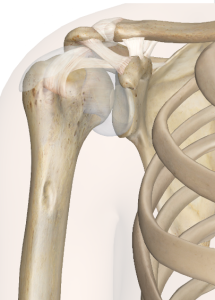 Another unconscious habit that can contribute to shoulder problems is lifting and pulling up and in at the shoulder joint. The shoulder joint is made up of the clavicle and shoulder blade coming together to form a round socket. The arm bone, the humerus, fits into this socket and too often we think of the head of the humerus as part of the joint. This thinking may be what causes us to pull up and in with the arm, creating more tension in our shoulders. Learning to recognize this habit is a step towards reducing the stress and tension we are putting on this joint. Learning to let the elbows drop will give more space to the joint. This action will also reduce wear and tear on the shoulder.
Another unconscious habit that can contribute to shoulder problems is lifting and pulling up and in at the shoulder joint. The shoulder joint is made up of the clavicle and shoulder blade coming together to form a round socket. The arm bone, the humerus, fits into this socket and too often we think of the head of the humerus as part of the joint. This thinking may be what causes us to pull up and in with the arm, creating more tension in our shoulders. Learning to recognize this habit is a step towards reducing the stress and tension we are putting on this joint. Learning to let the elbows drop will give more space to the joint. This action will also reduce wear and tear on the shoulder.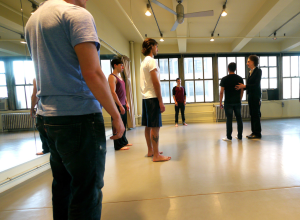
 Lucy’s Synopsis:
Lucy’s Synopsis: The way in which you might be the most familiar with the lymphatic system is in the tissue swelling (edema) and tenderness one can get during a cold, flu or after a surgery. Lymphatic massage can be beneficial towards the end cycle of illness and post-operatively, as well as helping to strengthen the immune system for those who suffer from allergies or autoimmune diseases. It is a group of gentle, relaxing massage techniques that support comfort, recovery and wellness. These techniques help increase the flow rate of lymph as it moves through the node areas, enhances lymph node function and aids in detoxification. There are many benefits of lymphatic massage. The reduction of edema is perhaps the most visually apparent benefit and has a wonderful ripple effect. Decrease of swelling supports reduction of pain, discomfort and stiffness, helps to lessen numbness and enables mobility of muscles and joint range of motion.
The way in which you might be the most familiar with the lymphatic system is in the tissue swelling (edema) and tenderness one can get during a cold, flu or after a surgery. Lymphatic massage can be beneficial towards the end cycle of illness and post-operatively, as well as helping to strengthen the immune system for those who suffer from allergies or autoimmune diseases. It is a group of gentle, relaxing massage techniques that support comfort, recovery and wellness. These techniques help increase the flow rate of lymph as it moves through the node areas, enhances lymph node function and aids in detoxification. There are many benefits of lymphatic massage. The reduction of edema is perhaps the most visually apparent benefit and has a wonderful ripple effect. Decrease of swelling supports reduction of pain, discomfort and stiffness, helps to lessen numbness and enables mobility of muscles and joint range of motion. One of the newest exercise machines, the ZAAZ, purports to move the lymphatic and circulatory systems as well as give you one hour of exercise all in 12 minutes.
One of the newest exercise machines, the ZAAZ, purports to move the lymphatic and circulatory systems as well as give you one hour of exercise all in 12 minutes.